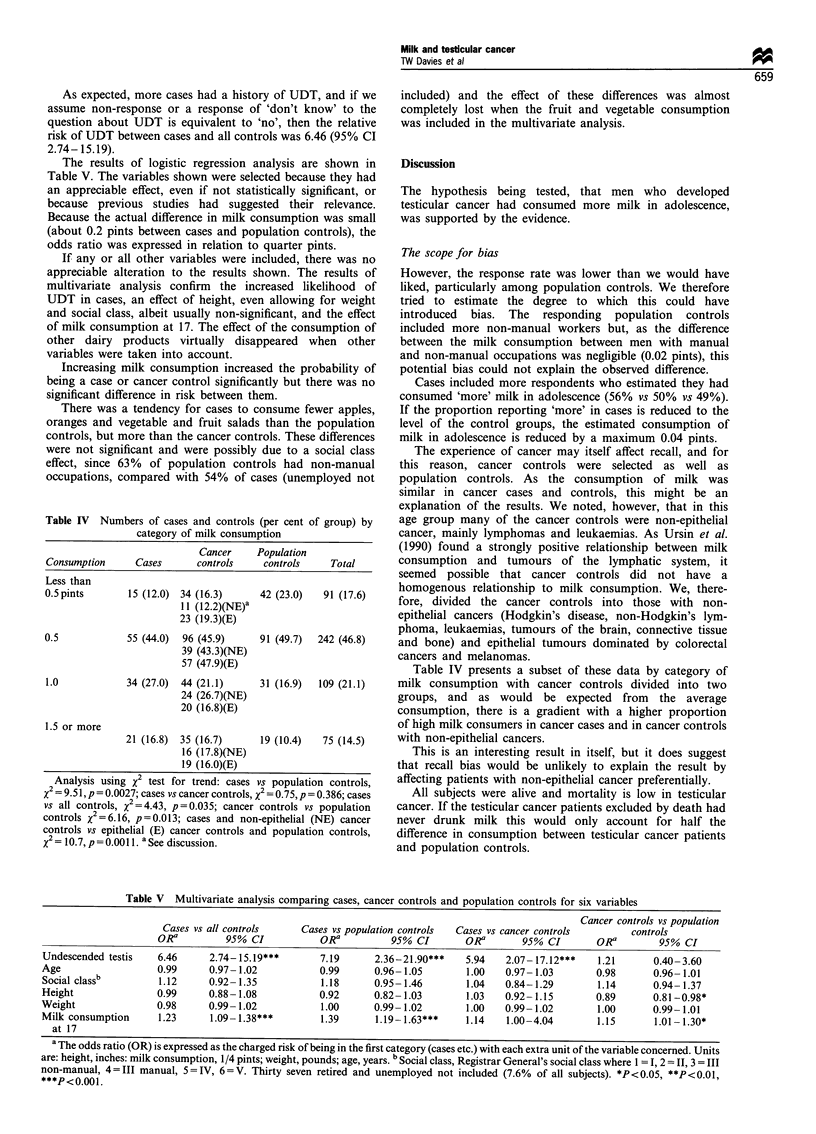Abstract
There is an association between dairy product consumption and the incidence of testicular cancer in different countries. To test the hypothesis that milk and dairy products are risk factors, a case-control study was performed in East Anglia, UK. All the cases were men with testicular cancer and for each of the 200 cases there were four controls, two cancer controls and two population controls. The response rate of those eligible subjects who received a questionnaire was: cases 73%, cancer controls 65% and population controls 57%. All responding subjects completed a dietary questionnaire including questions on current and adolescent milk, dairy product and fruit and vegetable consumption. The answers were corroborated when possible by the subjects' mothers using a separate questionnaire. Cases consumed significantly more milk in adolescence than population controls, but this difference did not apply to other dairy products or fruit. The consumption of milk by cancer controls was intermediate between cases and population controls. Cancer controls with non-epithelial cancers had a milk consumption similar to cases, whereas subjects with epithelial cancers had a consumption similar to population controls. In a multivariate analysis the odds ratio between cases and population controls for the association of undescended testis and testicular cancer was 7.19 (95% CI 2.36-21.9) and for each extra quarter pint of milk consumed it was 1.39 (95% CI 1.19-1.63).
Full text
PDF



Selected References
These references are in PubMed. This may not be the complete list of references from this article.
- Armstrong B., Doll R. Environmental factors and cancer incidence and mortality in different countries, with special reference to dietary practices. Int J Cancer. 1975 Apr 15;15(4):617–631. doi: 10.1002/ijc.2910150411. [DOI] [PubMed] [Google Scholar]
- Cheng K. K., Day N. E., Duffy S. W., Lam T. H., Fok M., Wong J. Pickled vegetables in the aetiology of oesophageal cancer in Hong Kong Chinese. Lancet. 1992 May 30;339(8805):1314–1318. doi: 10.1016/0140-6736(92)91960-g. [DOI] [PubMed] [Google Scholar]
- Giovannucci E., Stampfer M. J., Colditz G. A., Rimm E. B., Trichopoulos D., Rosner B. A., Speizer F. E., Willett W. C. Folate, methionine, and alcohol intake and risk of colorectal adenoma. J Natl Cancer Inst. 1993 Jun 2;85(11):875–884. doi: 10.1093/jnci/85.11.875. [DOI] [PubMed] [Google Scholar]
- Stearns E. L., MacDonnell J. A., Kaufman B. J., Padua R., Lucman T. S., Winter J. S., Faiman C. Declining testicular function with age. Hormonal and clinical correlates. Am J Med. 1974 Nov;57(5):761–766. doi: 10.1016/0002-9343(74)90850-x. [DOI] [PubMed] [Google Scholar]
- Ursin G., Bjelke E., Heuch I., Vollset S. E. Milk consumption and cancer incidence: a Norwegian prospective study. Br J Cancer. 1990 Mar;61(3):454–459. doi: 10.1038/bjc.1990.100. [DOI] [PMC free article] [PubMed] [Google Scholar]


